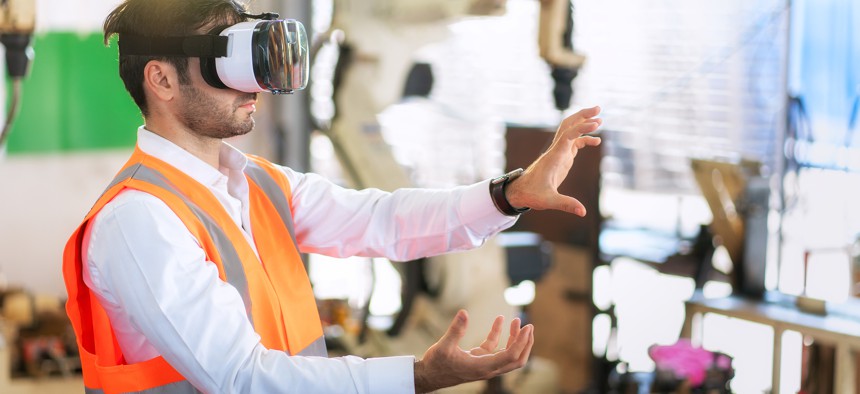States Look to Virtual Reality for Workforce Development

GettyImages/ Natnan Srisuwan
Alabama and Arkansas have been using the technology to familiarize potential workers with entry-level skills.
To pilot test a virtual reality training system, AIDT, Alabama’s workforce development agency, partnered with Lockheed Martin, a large employer in the state. The company was sponsoring a local high school program and deployed VR goggles and training modules to students there. On graduation, participants were offered jobs at the aerospace company.
“It gave these people unique job opportunities in which they made great money,” said Jacqueline Allen, AIDT’s assistant director of communications and external affairs. “Lockheed is one of many companies that we have that will pay for employees to go to college and get a four-year degree should they desire to do so. This opened up a whole new avenue to a workforce pool.”
About 40% of the 135 companies that AIDT recruits, trains and assesses employees for use a VR system provided by TRANSFR, a company that deliver VR workplace training and skills development. TRANSFR creates the training simulations and provides Oculus headsets for accessing them. When a company signs on with AIDT, the agency sends curriculum developers and videographers to the business to learn about its operations and create training manuals, videos and computer-based courses. Then AIDT provides all of that to TRANSFR to build simulations.
When the modules are ready for trainees to use, AIDT can dispatch its 25 mobile training units, which are wired for electricity and support Wi-Fi, or provide training onsite at company facilities. To take a course, people apply for jobs listed by AIDT, which then determines their suitability. If they meet minimum qualifications, they go to a training class. AIDT has 549 headsets in use.
“We are finding that people are able to grasp the information at a much faster rate, and that’s because this is kinesthetic learning,” Allen said. “That’s especially great because a lot of these jobs require a lot of dexterity and hand-eye coordination.”
Not all simulations are customized, said Bharani Rajakumar, founder and CEO of TRANSFR. The company has about 200 scenarios that home in on skills common to manufacturing jobs and skilled trades, and it adds new scenarios each month. The goal is to add another 180 this year, Rajakumar said.
“Because we focus on entry-level skills, if you’re learning precision measurement in Alabama, it’s a similar kind of skillset that you would learn all around the world,” he said. “We focus on those skills that help someone get their foot in the door.”
Customers get what he calls a “VR lab,” which comes with five licenses, each installed on a headset. Training can be part of the curriculum at a high school or college, an apprenticeship or a degree program. In addition to the job-specific training, TRANSFR provides career exploration modules that give users a brief look at various jobs.
“It’s like speed dating with occupations,” Rajakumar. “We have this one platform that can do both.”
Trainings come with a digital coach, named Simon after the game “Simon Says.”
In Arkansas, the Office of Skills Development turned to TRANSFR to help with what its director, Cody Waits, said was a “lack of awareness, lack of exposure [about job options] as well as trying to mitigate the expenses … with training individuals who are unfamiliar with the technology.” Welding training is expensive, he said. “If you’re able to expose individuals at an entry level to doing some of those basic skill sets in a virtual environment, you reduce waste, you reduce your spend on gas, materials, metal.”
Another benefit to the office is that it can reach more job-seekers and expose them to opportunities they might not know about. From there, they can dive more deeply into a specific training course.
Waits said he tells trainees: “We can put you in the virtual environment … and you can now go through multiple different situations where you’re earning stars.” They’re not necessarily earning a credential, but they’re “earning a certification within the headset” as they progress through the content, he said.
Supervisors and students can see what percentage of the training module they got right and where they made mistakes so they can easily review that material. “When they come to the actual hands-on pieces in the real lab, we know that they have a pretty good concept and idea of what to do,” Waits said.
The office distributed the first headsets last fall to 14 community colleges and the Northwest Arkansas Council, a workforce development organization. So far, the VR program has reached more than 200 students, and the office plans to serve more than 4,500 this year. On April 23, the office will meet with the governor-appointed Career Education and Workforce Development Board to discuss expanding the program’s reach, Waits said.
“We this not as a short-term fix, but a long-term strategy here in Arkansas,” he said.
Arkansas’ Allen also plans to expand the VR program. “We’re at a point now where when we start working with a company, they ask for it,” she said, adding that she also has her eye on using augmented reality for training in the future.





